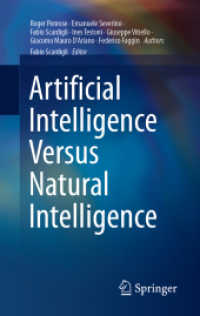- ホーム
- > 洋書
- > 英文書
- > Science / Mathematics
Full Description
The history of artificial cold has been a rather intriguing interdisciplinary subject (physics, chemistry, technology, sociology, economics, anthropology, consumer studies) which despite some excellent monographs and research papers, has not been systematically exploited. It is a subject with all kinds of scientific, technological as well as cultural dimensions. For example, the common home refrigerator has brought about unimaginably deep changes to our everyday lives changing drastically eating habits and shopping mentalities. From the end of the 19th century to the beginning of the 21st, issues related to the production and exploitation of artificial cold have never stopped to provide us with an incredibly interesting set of phenomena, novel theoretical explanations, amazing possibilities concerning technological applications and all encompassing cultural repercussions. The discovery of the unexpected and "bizarre" phenomena of superconductivity and superfluidity, the necessity to incorporate macroscopic quantum phenomena to the framework of quantum mechanics, the discovery of Bose-Einstein condensation and high temperature superconductivity, the use of superconducting magnets for high energy particle accelerators, the construction of new computer hardware, the extensive applications of cryomedicine, and the multi billion industry of frozen foods, are some of the more dramatic instances in the history of artificial cold.
Contents
Foreword.- About the Authors.- Table Of Contents.- The History of Artificial Cold -Historiographical issues; Kostas Gavroglu.- Investigating the Very Cold.- Early modern history of cold: Robert Boyle and the emergence of a new experimental field in 17th century experimental philosophy; Christiana Christopoulou.- James Dewar and the Road to the Liquefaction of Hydrogen; Sir John S. Rowlinson.- The cryogenic laboratory of Heike Kamerlingh Onnes: an early case of Big Science; Dirk van Delft.- Superconductivity—a challenge to modern physics; Christian Joas and Georges Waysand.- Superfluidity: how quantum mechanics became visible; Sébastien Balibar.- The physics of cold in the Cold War: "On-line computing" between the ICBM program and superconductivity; Johannes Knolle and Christian Joas.- Industries of Cold.- Domestic Ice-Making Machines 1830-1930; Simon Reif-Acherman.- Carl Linde and his relationship with Georges Claude: The cooperation between two independent inventors in cryogenics and its side effects; Hans-Liudger Dienel.- Meeting Artificial Cold: Expositions and Refrigeration, 1896-1937; Guillaume de Syon.- Consuming Cold.- The introduction of frozen foods in West Germany and its integration into the daily diet; Ulrike Thoms.- The Means of Modernization: Freezing Technologies and the Cultural Politics of Everyday Life, Norway 1940-1965; Terje Finstad.- The Invention of Refrigerated Transport and the Development of the International Dressed Meat Trade; Jonathan Rees.- 'Fresher than fresh'. Remarks on consumer attitudes towards the development of the Cold Chain in post-WWII Greece; Faidra Papanelopoulou.- Index.








